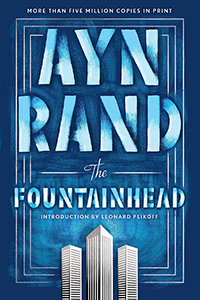The Fountainhead
“The Fountainhead” is a novel written by Ayn Rand and published in 1943. It explores themes of individualism, integrity, and the conflict between social conformity and personal vision. Here’s a summary of the key themes and plot elements of the book:
Plot Summary:
1. Protagonist and Antagonists:
– The protagonist, Howard Roark, is an innovative and uncompromising architect who believes in creating buildings that express his unique artistic vision. Roark is contrasted with several antagonists, including Peter Keating, a fellow architect who achieves success by conforming to popular tastes, and Ellsworth Toohey, a manipulative architectural critic who seeks to suppress individualism in favor of collectivism.
2. Roark’s Career and Relationships:
– The novel follows Roark’s career as he faces professional and personal challenges. Despite initial setbacks and opposition from traditionalists in the architectural world, Roark eventually gains recognition for his innovative designs. His relationships, particularly with the fiercely independent Dominique Francon, illustrate his commitment to his principles and his struggle against societal pressures.
3. Conflict and Controversy:
– The central conflict of the novel revolves around Roark’s quest to maintain artistic integrity in the face of societal expectations and institutionalized conformity. The novel explores themes of ambition, power, and the tension between individualism and collectivism.
4. Architectural Philosophy:
– Through Roark’s character and his interactions with other architects and clients, Ayn Rand explores her philosophy of Objectivism, which emphasizes rational self-interest, individual rights, and the pursuit of personal happiness. Roark’s architectural creations are depicted as symbols of his uncompromising commitment to his own values and vision.
5. Climax and Resolution:
– The novel builds to a climax involving a controversial building project that tests Roark’s principles and challenges societal norms. The resolution underscores the consequences of Roark’s uncompromising individualism and celebrates the triumph of personal integrity over external pressures.
Key Themes:
– Individualism vs. Conformity: The novel explores the tension between individuals who pursue their own goals and those who conform to societal expectations and norms.
– Integrity and Authenticity: Roark’s character exemplifies the importance of integrity and authenticity in pursuing one’s vision and principles, even in the face of opposition and adversity.
– Critique of Collectivism: Ayn Rand critiques collectivist ideologies that prioritize the interests of the group over the rights and freedoms of the individual, advocating instead for individual rights and personal autonomy.
– Art and Innovation: “The Fountainhead” celebrates creativity, innovation, and the transformative power of art and architecture as expressions of individualism and human potential.
Cultural Impact:
– “The Fountainhead” has had a lasting impact on literature and popular culture, influencing discussions about individualism, creativity, and the role of the artist in society.
– The novel continues to provoke debate and interpretation, with its themes resonating with readers who are interested in philosophical questions about ethics, identity, and the pursuit of happiness.
Conclusion:
“The Fountainhead” remains a significant work of fiction that explores profound philosophical themes through its compelling characters and narrative. Ayn Rand’s portrayal of Howard Roark’s uncompromising pursuit of individualism and artistic integrity continues to captivate readers and provoke thought about the nature of creativity, freedom, and the pursuit of one’s own happiness in a complex and often conformist world.

